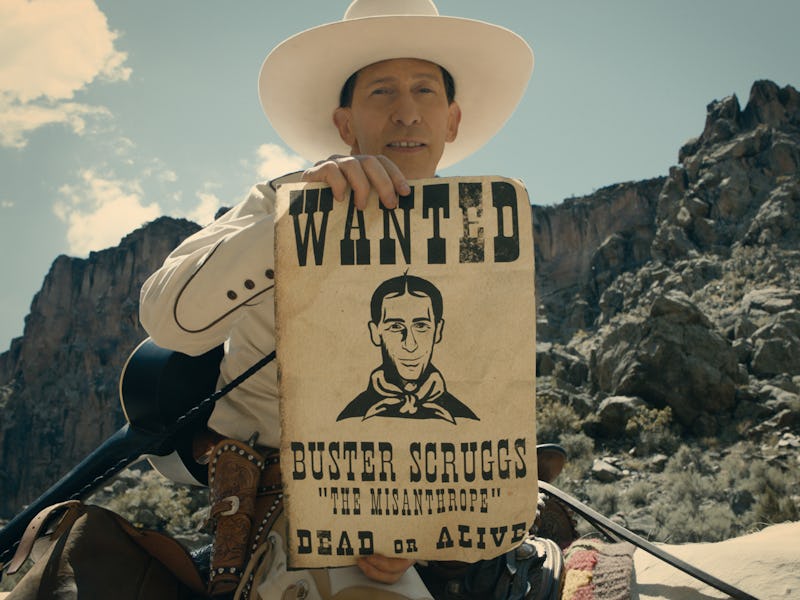The Best Western of the Decade Is One of Netflix’s Greatest Hidden Gems
Of all of Netflix’s many auteur collaborations, this is one of the most underrated.

In the years since it began its bid to take over Hollywood, Netflix has emerged as an outlet for major filmmakers to make movies that other studios might not have shown much interest in. From Martin Scorsese (The Irishman) to David Fincher (Mank, The Killer) and Noah Baumbach (White Noise), the streaming service has worked with more iconic, acclaimed filmmakers over the past six years than most other studios. Unfortunately, Netflix has also failed to promote some of the projects that have come from its auteur collaborations as extensively as it should have.
Many worthwhile, impressive films have consequently been swallowed up by the company’s ever-growing library of original programming, including The Ballad of Buster Scruggs. Written and directed by the Coen Brothers, the eclectic Western anthology film was quietly added to Netflix’s platform in the fall of 2018 — and its release was only truly noted at the time by certain in-the-know cinephiles. Many critics, meanwhile, seemed to shrug the film off as a decidedly minor effort on the part of the Coens.
Five years after its release, though, The Ballad of Buster Scruggs ranks high as one of the most uniquely entertaining and enduring movies that Netflix has ever produced. In fact, it’s difficult to name any other mainstream Western from the past decade that is as beautifully made, thought-provoking, and haunting as The Ballad of Buster Scruggs.
The Ballad of Buster Scruggs is practically overflowing with the kind of zany, unforgettable characters that only the Coen Brothers could create.
The only anthology film that Joel and Ethan Coen have ever made, The Ballad of Buster Scruggs is comprised of six short stories that are connected by little more than their style and shared Old West setting. The movie’s first section follows its titular gunslinger (Tim Blake Nelson) as he sings songs, takes names, and eventually meets a young gun who’s inevitably faster than him, while its third is a chillingly dark slice of short fiction about a mercenary impresario (Liam Neeson) and a disabled performer (Harry Melling) whose survival seems to depend entirely on his fiscal value.
The latter section is one of The Ballad of Buster Scruggs’ most emotionally impactful, placing second solely behind the film’s longest and best story, “The Gal Who Got Rattled.” A concise romantic drama about a relationship that unexpectedly blossoms between a wagon train leader (Bill Heck) and a young woman (Zoe Kazan), the segment contains the emotional scope of a three-hour epic and concludes with a shot that ranks high among the best that the Coen Brothers have ever composed.
There are, of course, certain sections of The Ballad of Buster Scruggs that don’t work as well as others. But even the film’s less memorable parts combine with its others to create a comprehensive, artistically stirring portrait of not just the Old West itself, but the entire Western genre. Over the course of its 133-minute runtime, the film manages to feature versions of the various images, archetypes, and stories that have come to define its genre, all while reinventing them in its own vibrant, occasionally cartoonish ways. (Rarely has a gunslinger ever been depicted the way that Blake Nelson’s singing killer is in the film’s opening segment.)
It’s worth seeking out The Ballad of Buster Scruggs just to experience the rush of emotions that come when it reaches this moment.
Beyond the impressively expansive tonal and thematic landscape that it creates, The Ballad of Buster Scruggs is an incredible testament to the unmatched, inimitable skills of its creators. The entire film is composed with the Coen Brothers’ trademark, lyrical editorial cadence — the scripts for each of its sections reverberating with the same wry, darkly observational sense of humor that has long defined their work. At nearly every turn, the movie is able to hit you with a new, breathtaking stylistic flourish, visual gag, or cut. (See, for instance, the way that the Coens choose to visually reveal the death of one major character near the end of Buster Scruggs’ first segment.)
Five years after its release, it’s hard to see The Ballad of Buster Scruggs as anything less than another singular offering from two of the most accomplished American filmmakers of the past 50 years. It’s a movie that deserves to be discussed far more often than it is, and that deserves to be rescued from the forgotten corner of the streaming space that it has been relegated to since 2018.